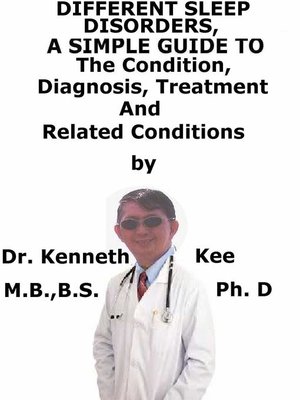Different Sleep Disorders, a Simple Guide to the Condition, Diagnosis, Treatment and Related Conditions
ebook
By Kenneth Kee

Sign up to save your library
With an OverDrive account, you can save your favorite libraries for at-a-glance information about availability. Find out more about OverDrive accounts.
Find this title in Libby, the library reading app by OverDrive.



Search for a digital library with this title
Title found at these libraries:
| Library Name | Distance |
|---|---|
| Loading... |
This book describes Different Sleep Disorders, Diagnosis and Treatment and Related Diseases
Sleep is something which every one needs.
It helps to relax the mind and permits the body to rest and rejuvenate itself.
Sleep disorders are a group of disorders that influence the ability to sleep well on a regular basis.
More than 70 percent of high school students document getting fewer than 8 hours of sleep on weeknights.
Most people occasionally have sleeping disorders due to stress, hectic schedules, and other outside influences.
When these disorders start to happen on a regular basis and disrupt daily life, they may indicate a sleeping disorder.
Depending on the type of sleep disorder, different people may have a difficult time falling asleep and may feel very tired throughout the day.
The lack of sleep can have a negative effect on energy, mood, concentration, and overall health.
In some cases, sleep disorders can be a symptom of another medical or mental health disorder.
These sleeping disorders may finally go away when treatment is obtained for the underlying cause.
When sleep disorders are not produced by another disorder, treatment normally requires a combination of medical treatments and lifestyle changes.
It is important to receive a diagnosis and treatment immediately if the doctor suspects the patient might have a sleep disorder.
When left untreated, the negative effects of sleep disorders can cause further unhealthy results.
They can also influence the performance at work, cause strain in relationships, and harm the ability to do daily activities.
General symptoms of sleep disorders are:
1. Difficulty falling or staying asleep
2. Daytime fatigue
3. Strong urge to take naps during the day
4. Unusual breathing patterns
5. Unusual or unpleasant urges to move while falling asleep
6. Unusual movement or other experiences while asleep
7. Unintentional changes to the sleep/wake schedule
8. Irritability or anxiety
9. Impaired performance at work or school
10. Lack of concentration
11. Depression
12. Weight gain
Polysomnography (PSG) is a lab sleep study that assesses oxygen levels, body movements, and brain waves to determine how they disturb sleep vs. home sleep study (HST) that is done at home and is utilized to diagnose sleep apnea.
Multiple sleep latency test (MSLT) is a daytime napping study done in conjunction with a PSG at night to help diagnose narcolepsy.
Electroencephalogram (EEG) is a test that evaluates electrical activity in the brain and detects any possible disorders linked with this activity.
These tests can be important in deciding the right course of treatment for sleep disorders.
Medical treatment for sleep disturbances might involve:
1. Sleeping pills
2. Melatonin supplements
3. Allergy or cold medication
4. Medications for any underlying health disorders
5. Breathing device or surgery (normally for sleep apnea)
6. A dental guard (normally for teeth grinding)
Lifestyle alterations can greatly enhance the quality of sleep, especially when they are done along with medical treatments.
The patient may want to consider:
1. Incorporating more vegetables and fish into the diet, and reducing sugar intake
2. Reducing stress and anxiety by exercising and stretching
3. Creating and sticking to a regular sleeping schedule
4. Drinking less water before bedtime
5. Limiting the caffeine intake, especially in the late afternoon or evening
6. Decreasing tobacco and alcohol use
7. Eating smaller low carbohydrate meals...







